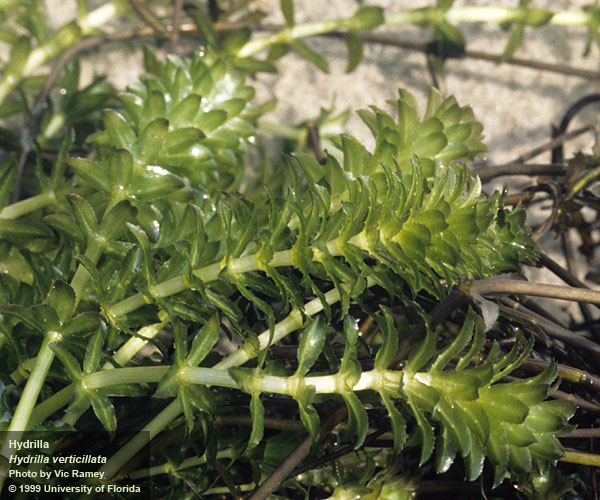EDRR Invasive Species
Hydrilla (Hydrilla verticillata)
Define Invasive Species: must have ALL of the following –
- Is non-native to the area, in our case northwest Florida
- Introduced by humans, whether intentional or accidental
- Causing either an environmental or economic problem, possibly both
Define EDRR Species: Early Detection Rapid Response. These are species that are either –
- Not currently in the area, in our case the Six Rivers CISMA, but a potential threat
- In the area but in small numbers and could be eradicated
Native Range:
India.
Introduction:
Intentionally introduced in 1950-51 as a plant for aquariums.
EDDMapS currently list 3,592 records of this plant in the U.S. and Canada. Most are east of the Mississippi River. There are 370 records in Florida (certainly underreported) and 91% of those are in central and south Florida. There are only 33 records in the Florida panhandle but none of those are within the Six Rivers CISMA (Escambia, Santa Rosa, Okaloosa, Walton, Holmes, and Washington counites. There are four records from the Mobile delta, which lies in Baldwin County Alabama and is part of Six Rivers.
Description:
This is a submerged aquatic plant that will grow up to and across the surface of freshwater habitats. It can grow to lengths of 20 feet. Small whorled, saw-toothed, and pointed green leaves grow from the stem. Small solitary white flowers grow from extended threadlike stalks coming from the stems and resting on the surface. Can form dense mats at the surface.
Issues and Impacts:
The fast growing dense mats of Hydrilla block out sunlight needed by native submerged plants and cause their decline. These thick mats can reduce the natural flow of rivers and springs it invades altering the hydrology and ecology of the system, often reducing the dissolved oxygen levels. It has been known to clog irrigation and flood control canals as well as actually impede boating on some waterways.
The plant is extremely hardy being found in canals and ditches as shallow as a few feet to rivers, lakes and springs up to depths of 20 feet.
It is listed as a Florida Noxious weed and is prohibited from being sold.
Management:
Small infestations can be removed by hand or pulling out using a rake. The plant should be placed in a location where it can completely dry out and die. Those who can manage the levels of their lakes and ponds and draw down the water and kill the plant that way.
For larger infestations of lakes and springs, mechanical “mowers” can be used to cut and remove large areas of the plant. The removed pieces are then deposited into trucks on shore for further desiccation and disposal. Large mats not removed can increase hypoxia in the waterway. One issue with this method is fragments that are missed can generate into new plants.
There are six insects and one fish (Chinese Grass Carp) that have been used to biologically control the plant. However, establishment of these insects have been problematic. The Chinese Grass Carp do well on hydrilla but will feed on other aquatic plants and breeding populations could be a problem for the native ecology. Thus, only sterile triploid carp are allowed to be used and only with an FWC permit. Read more about these biological control agents at the reference below2.
There are several chemical herbicides that have had some success. For more information on using those, contact your local county extension office.
If you are in the Florida panhandle area and believe you may have hydrilla, please contact your county extension office to let them know and report the siting to www.EDDMapS.org. If you have questions on how to do this, your county extension office can help.
For more information on this EDRR species, contact your local extension office.
References
1 University of Florida IFAS Center for Aquatic and Invasive Plants. Hyrdilla. https://plants.ifas.ufl.edu/plant-directory/hydrilla-verticillata/.
2 Biological Controls. Plant Management in Florida Waters: An Integrated Approach. 2021. Center for Aquatic and Invasive Plants. University of Florida IFAS. https://plants-archive.ifas.ufl.edu/manage/control-methods/biological-control/.
Early Detection and Distribution Mapping System (EDDMapS)
Six Rivers CISMA
https://www.floridainvasives.org/sixrivers/
- Our Environment: Part 10 – Improving Agriculture - June 20, 2025
- Marine Creatures of the Northern Gulf – Snails and Slugs - June 20, 2025
- Our Environment: Part 9 – Agriculture Challenges - June 6, 2025

